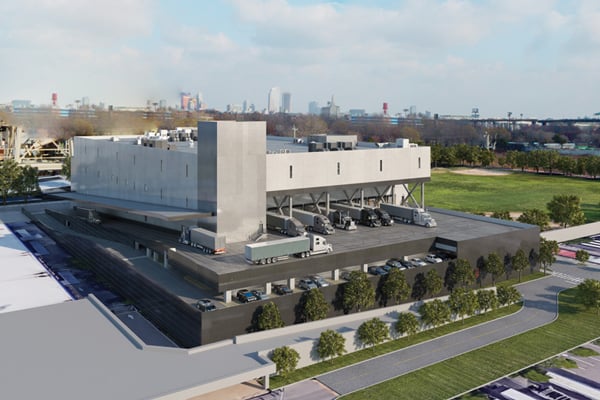Change Accelerates in Supply Chains and Industrial Real Estate

How advancements in transportation, technology and construction continue to converge.
Global economic uncertainty, rapid technological advances and pressure from e-commerce are forcing radical innovation in supply chains. With transportation and the movement of goods and materials making up a significant portion of total logistics operating costs, these innovations are altering the logistics landscape. They allow supply chain and transportation managers to focus on cost efficiency, profitability and service to clients.
However, changes in individual sectors of logistics are not progressing at the same pace. Some are being deployed. Others may not live up to expectations. As trends such as faster e-commerce fulfillment, more urban deliveries, and autonomous trucking and robotics continue to converge, what will be the impact on industrial real estate?
Conceptually, these trends can be segmented into a few different categories: those affecting transportation and the movement of goods; geographic and site-selection trends; innovations in warehouse design and development; and other technological innovations that can bring greater operational efficiency to logistics operations.
Longer-term, secular shifts toward new technology adoption may change the site-selection calculus on location decisions and network optimization for tenants. Likewise, for investors seeking diversification or developers seeking new opportunities, these tectonic changes in supply chain management practices could alter many segments of the industrial real estate market in years to come.
Trends Across Transportation
Trucking will continue to be the primary means of goods movement in the U.S., says Ben Conwell, senior managing director and practice leader of the Logistics & Industrial Services Group at Cushman & Wakefield.
In 2018, trucking constituted 71.4% of all U.S. freight transportation and 80.3% of revenues, according to the American Trucking Association’s “ATA Freight Transportation Forecast: 2019 to 2030,” published in August 2019.
And while total freight tonnage is projected to grow 25.6% from 2019 to 2030, trucking’s relative proportions of tonnage and revenue are expected to dip slightly as other modes of transport battle for market share. Intermodal rail, air and domestic waterborne transportation should see modest growth.
At U.S. seaports, containerized import volumes keep trending upward. The four largest port gateways (Los Angeles/Long Beach, New York/New Jersey, Savannah and Seattle/Tacoma) handled 65% of the national total in 2017. Importers increasingly use these ports in their “Four Corner” international supply chain risk management strategy, with a major seaport on the north/south ends of each coast creating connectivity throughout the country, according to Walter Kemmsies, managing director for JLL’s U.S. Ports, Airports & Global Infrastructure Group.
Container imports from Asia are the dominant volume handled by U.S. ports. Los Angeles/Long Beach has the largest share, with 40% of its imports transported to the Midwest by intermodal rail, Kemmsies says. And while tariff uncertainty has created anxiety within global supply chains, it has been a boon for industrial real estate on the West Coast as companies attempt to get ahead of tariff levies, according to Jon Pharris, co-founder and president of CapRock Partners.
It takes more than 11,000 one-way truck trips to load and unload a 14,000 TEU (20-foot equivalent unit) shipping vessel, Kemmsies says. With congestion an ever-present obstacle, inland ports are viewed as a potential solution to supplement long-haul trucking while reducing container dwell times at packed marine terminals. According to Kemmsies, railroads and private developers initiate most inland port developments. Others are springing up around emerging clusters of distribution centers. Port authorities in Georgia, South Carolina, Virginia and New York/New Jersey are also investing in inland ports.
Driver shortages in trucking compound shipping dilemmas. Rising freight volumes have only made the shortage more acute. According to the American Trucking Association’s “2019 Truck Driver Shortage Analysis,” published in July, the industry was short roughly 60,800 drivers in 2018, up nearly 20% from 50,700 in 2017. If current trends hold, the shortage could exceed 160,000 by 2028, according to the report.
Is autonomous trucking a solution? It continues to evolve, but technological limitations persist around sensors and LIDAR (light detection and ranging), the laser technology that enables driverless vehicles to “see” the roadway and other vehicles. Regulatory and public sentiment hurdles remain significant as well, Kemmsies says.
“We won’t see purely driverless long-haul trucks, but more likely drivers will use autopilot on highways and sit in the back of the cab so the HOS (hours of service) regulations are suspended,” he says. “They can augment labor productivity, but not eliminate it.”
Despite that, companies continue to invest in the technology. For example, UPS has funded autonomous driving company TuSimple. It will test self-driving tractor trailers on a single route in Arizona to determine if the vehicles can improve service and efficiency.
Conwell says the potential for growth in air freight is an untold story right now. Speed-to-market pressure will boost demand for this service during the next five to 10 years. Growth will come not just for cargo inbound into the U.S., but also outbound. Leading the way will be high-end goods that are in demand around the world from growing economies. Kemmsies adds that volumes may also increase for short shelf-life goods and urgent-delivery parcels such as medications.
Amazon continues to build out its Amazon Air freight fleet, leasing an additional 15 Boeing 737-800 cargo aircraft in mid-2019 from GE Capital Aviation Services (GECAS).
“By 2021, Amazon Air will have a portfolio of 70 aircraft flying in our dedicated air network,” says Dave Clark, senior vice president of worldwide operations at Amazon.
Sustainability is another important trend in transportation. The IMO 2020 regulations from the International Maritime Organization, an agency of the United Nations, will limit the release of sulphur oxides to improve air quality in port cities and reduce ocean acidification. That could lead to higher fuel prices, says Kemmsies, as well as “the implication that in the future, even larger ships will be preferred to smaller ones due to economies of scale, and trains will be preferred to trucks. We are in the early stages of migrating to larger ships and trains to move a lot more of our cargo.”
In the United Kingdom, UPS is introducing a new hybrid delivery truck fleet as emissions regulations tighten. While purely electric trucks have range limitations of about 100 kilometers (62 miles), their Range Extended Electric Vehicles (REEVs) use a dual fuel system that allows them to go four times farther. This will improve connections between inner-city distribution hubs and out-of-town depots.

Shifts in e-commerce are forcing distribution centers to change their designs. For example, 640 Columbia is the first multistory logistics facility on the East Coast. The three-story structure is located in Brooklyn, New York. Rendering Courtesy of Ware Malcomb
Additionally, the costs associated with requirements for electronic logging devices in trucking have helped shift highway cargo from Mexico to ocean cargo in Florida, says Eric Olafsun, director, Global Trade & Business Development at PortMiami. He adds that other technology and expertise, such as RFID on containerized shipments, satellite tracking and advances in refrigerated containers, creates greater port connectivity. This means more seamless shipping and better partnerships throughout the supply chain.
This is especially true as e-commerce delivery turnaround times speed up, and major port-centric markets are benefiting, says Olafsun. The need for more climate-controlled shipping is leading to cold-storage requirements, as consumers push for organic and fresh produce.
And as companies innovate last-mile deliveries, more automation and robotic concepts are being tested and adapted. While drone delivery is still in the early stages of testing, look for parcel delivery bots to be scaled more quickly than widespread air deliveries. According to Conwell, they’ll be deployed from a step van onto sidewalks.
In August 2019, Postmates received approval from San Francisco to begin testing its Serve delivery robot on city streets, according to a report from TechCrunch. And Supply Chain Dive reports that Ford has partnered with Agility Robotics to test Digit, a two-legged autonomous delivery robot that will pair up with an autonomous delivery vehicle. Digit can carry up to 40 pounds and navigate stairs.
Meanwhile, delivery drones are beginning to receive FAA approval. Amazon received permission to test its Prime Air drone in June 2019. Google’s Wing was approved in April 2019.
Right Place, Right Time
Multiple factors are driving innovation in logistics, including transportation cost pressures, accurate shipping timeframes and constricted delivery windows. But one of the biggest is increasing demands from e-commerce consumers for “instant gratification” that is even more instant.
“Never has demand for optimal location selection been more important, having goods in the right place at the right time,” Conwell says. “For some retailers, too much of the focus on transportation costs is on the outbound side to consumers. However, inbound transportation costs are garnering increased attention as companies look to optimize decisions. There is a relentless focus on optimizing delivery costs and where a facility in a distribution network should be located. These are complex decisions that are not done in a vacuum.”
Retailers are facing especially strong demand in cities and urban areas. They are building facilities close to customers to minimize transportation and congestion costs, even though the real estate might be more expensive.
According to Michael K. Bennett, principal at Ware Malcomb who is responsible for leadership of its northeast region, there is “a definite trend toward urban locations to service last-mile or just-in-time delivery, to be closer to consumers. And that can be a balancing act, making multiple outbound delivery runs in box trucks and sprinter vans while replenishing via semi-truck traffic.”
When choosing between satellite distribution centers or urban depots, companies are considering multiple options, Bennett says. But it is also important to consider locations that can house urban truck fleets and to design sites around parking needs.
“E-commerce companies have been incredibly strategic about distribution center locations and the need to be near major, dense populations centers,” Pharris says.
There is pressure to grow distribution networks beyond the legacy top distribution hubs such as the Inland Empire in Southern California, Dallas-Fort Worth, Atlanta, Miami, Northern New Jersey or Chicago, adds Conwell. Now, “historically alternative” markets are drawing significant occupier and investor interest, including places like Nashville, Salt Lake City, Kansas City or Greenville/Spartanburg, South Carolina, to name a few.
Once location decisions have been made, says Kemmsies, there are sunk costs on real estate, truck shipping and labor. “Does this mean a shift to rail-served markets or a focus on more automation?” he adds. “It is about finding the right balance in network optimization models.”
“There has been a persistent paradigm shift in proper labor availability, quality and predictability — either in a pure distribution center or in an omni-channel facility and especially around holiday seasons or other surges,” Conwell says. “More complex and deeper-dive labor analytics have become an increasingly important aspect of the site selection process.”
Inside and Outside ‘The Box’
Shifts in e-commerce are also changing the design and layout of distribution centers.
Outside the building, there is more demand for truck and trailer parking, as well as for dedicated areas for truck staging, parking and loading. This requires efficient yard management systems to control traffic flow and ensure the proper speed for throughput activities. If autonomous vehicles are circulating outside a distribution center in the future, another layer of management will likely be needed.
Urban logistics facilities can affect FAR (floor-to-area) ratios, but because many urban sites may have once been manufacturing plants or zoned for other uses, they often already have higher ratios, Bennett says. However, they do allow for more creative solutions, such as parking above truck courts and speed bays.
“As design moves into four or five stories, you can introduce even more solutions for parking,” he says.
Pharris adds that clear height requirements will affect not only multistory design across markets, including the number of levels and new parking accommodation constraints, but also the range of goods that common U.S. trucking can deliver due to the steeper grade of ramping. There are zoning, FAR, coverage and truck-circulation considerations that must be worked out in different municipalities.
Distribution centers are getting taller, too. Many are moving toward 40-foot clear or potentially higher, especially e-commerce facilities. They require more power for conveyors, robots, connectivity and other automated processes, and additional clear heights allow for more mezzanine and multilevel picking and packing operations.
Moreover, more companies are partnering to create and test new technological innovations.
“It is a quantum leap in adaptability,” said Conwell. “There is a surging collection of developers putting potential solutions on the market. Within urban logistics, innovation is underway around driverless vehicles and also final delivery bots. Multiple automakers are partnering up with tech companies, joined in large measure by food delivery companies. Food delivery is a low-risk prototype function, as surveys find a significant share of the U.S. population is not comfortable enough to ride in driverless vehicles, but they are comfortable with their dinner order riding in one.”
New partnerships are being enabled along every mile of the supply chain as well, from the ports to shipping lines to third-party logistics operators, says Olafsun.
According to a recent article in Supply Chain Dive, robotics companies are beginning to offer robotics-as-a-service solutions (RaaS) to help companies mitigate the heavy capital investment and learning curve for automated deployments. The Supply Chain Dive report references a study from ABI Research showing that RaaS will grow from 4,442 units in 2016 to 1.3 million in 2026, and annual revenues will increase from $217 million in 2016 to nearly $34 billion in 2026.
And while power requirements have been going up for highly automated users when compared to bulk distribution, those needs may level off as automation becomes more prevalent and efficient, Bennett says.
“There is a trade-off in energy usage, with the potential for lower lighting levels in more mechanized facilities that have less floorspace occupied by people, as well as differing needs for climate control, heating and cooling for people vs. machines,” he says.
Bennett also sees the potential for geofencing in the property and in the yard to improve operational efficiency. This technology would help drivers with sensors in their vehicles plan delivery trips better.
“It ties into the term ‘full visibility logistics,’ with companies becoming more able to self-perform or use third-party logistics while understanding real-time stock movements and implementing an elaborate warehouse management system (WMS),” he says.
However, labor availability has remained tight for warehouse and fulfillment centers, and companies are seeking a better work-life balance for warehouse employees.
“Workers are a priority for industrial tenants, so that means designing buildings with more glass lines, higher finishes, better break rooms and EV charging station, as well as LEED certification,” Pharris says.
The Digitization of Supply Chains
A growing assemblage of technology and software innovations touches the logistics market. However, fragmentation of data and systems continues to limit transportation supply chains. Manufacturers, shippers and clients often lack unified data and systems, which creates limitations on end-to-end visibility.
Through artificial intelligence, data automation or systems integration, technology providers continue to advance “big data” solutions to help companies optimize operations, from route planning to sensor technology. Transportation management systems (TMS) could become more sophisticated with greater data integration, and freight matching or freight APIs (Application Programming Interface) are continuing to push the boundaries of shipping efficiency.
Blockchain implementation continues to evolve rapidly in the supply chain, but it still faces limitations in its early stages of development. It continues to be an important tool to advance traceability, accountability, transparency and safety within the supply chain. While it cannot track all SKUs for a company, it can follow boxes or shipping containers, according to Kemmsies.
An Open Playing Field
As e-commerce continues to permeate the consumer economy, innovation in transportation logistics will likely accelerate. However, many of these advances remain fragmented into silos. Until they draw closer to one another, it could be years before practical solutions are in place.
“No one has the visibility yet,” Kemmsies says of disconnected trends in shipping technologies, both domestically and globally. “Innovations have to be diffused easily across countries and around the world, or else they fail. There have been many attempts to initiate change in containerized trade, but many efforts have failed because solutions in one economy don’t always work in another.”
And that has significant implications in the near-term future for industrial real estate site selection and development in the U.S.
“Physical and digital information infrastructures need to be aligned,” Kemmsies says. “There needs to be realism in what to expect. You can’t just jump from 1% to 100% implementation on any new trend that fast.”
Pharris notes that the commercial real estate industry needs to consider how to future-proof new construction. There is no clear idea yet what that requires, especially in a rapidly changing environment that must consider parking accommodations, clear heights and power requirements, to name only a few.
Despite that, the next few years should be interesting and exciting as these technologies evolve and create increased sophistication in logistics operations and new “physical” real estate requirements from warehouse occupiers.
Aaron Ahlburn is a real estate researcher and writer based in California.




